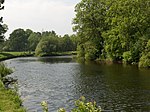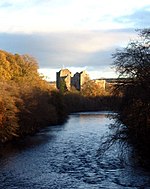Stirling torcs
2009 archaeological discoveries2009 in ScotlandAncient Celtic metalworkArchaeological sites in Stirling (council area)Gold objects ... and 5 more
Hoards from Iron Age BritainIron Age ScotlandMetal detecting finds in ScotlandTorcsTreasure troves in Scotland

The Stirling torcs make up a hoard of four gold Iron Age torcs, a type of necklace, all of which date to between 300 and 100 BC and which were buried deliberately at some point in antiquity. They were found by a metal detectorist in a field near Blair Drummond, Stirlingshire, Scotland on 28 September 2009. The hoard has been described as the most significant discovery of Iron Age metalwork in Scotland and is said to be of international significance. The torcs were valued at £462,000, and after a public appeal were acquired for the National Museums of Scotland in March 2011.
Excerpt from the Wikipedia article Stirling torcs (License: CC BY-SA 3.0, Authors, Images).Stirling torcs
Cuthil Brae,
Geographical coordinates (GPS) Address Nearby Places Show on map
Geographical coordinates (GPS)
| Latitude | Longitude |
|---|---|
| N 56.17105 ° | E -4.047779 ° |
Address
Cuthil Brae
Cuthil Brae
FK9 4XQ
Scotland, United Kingdom
Open on Google Maps








